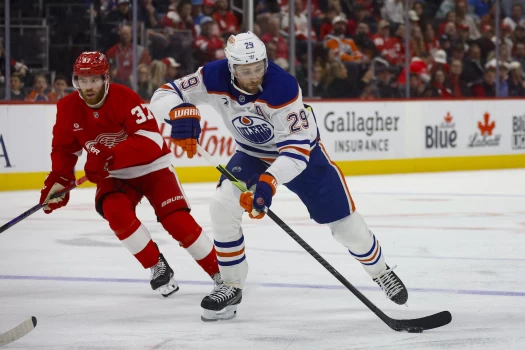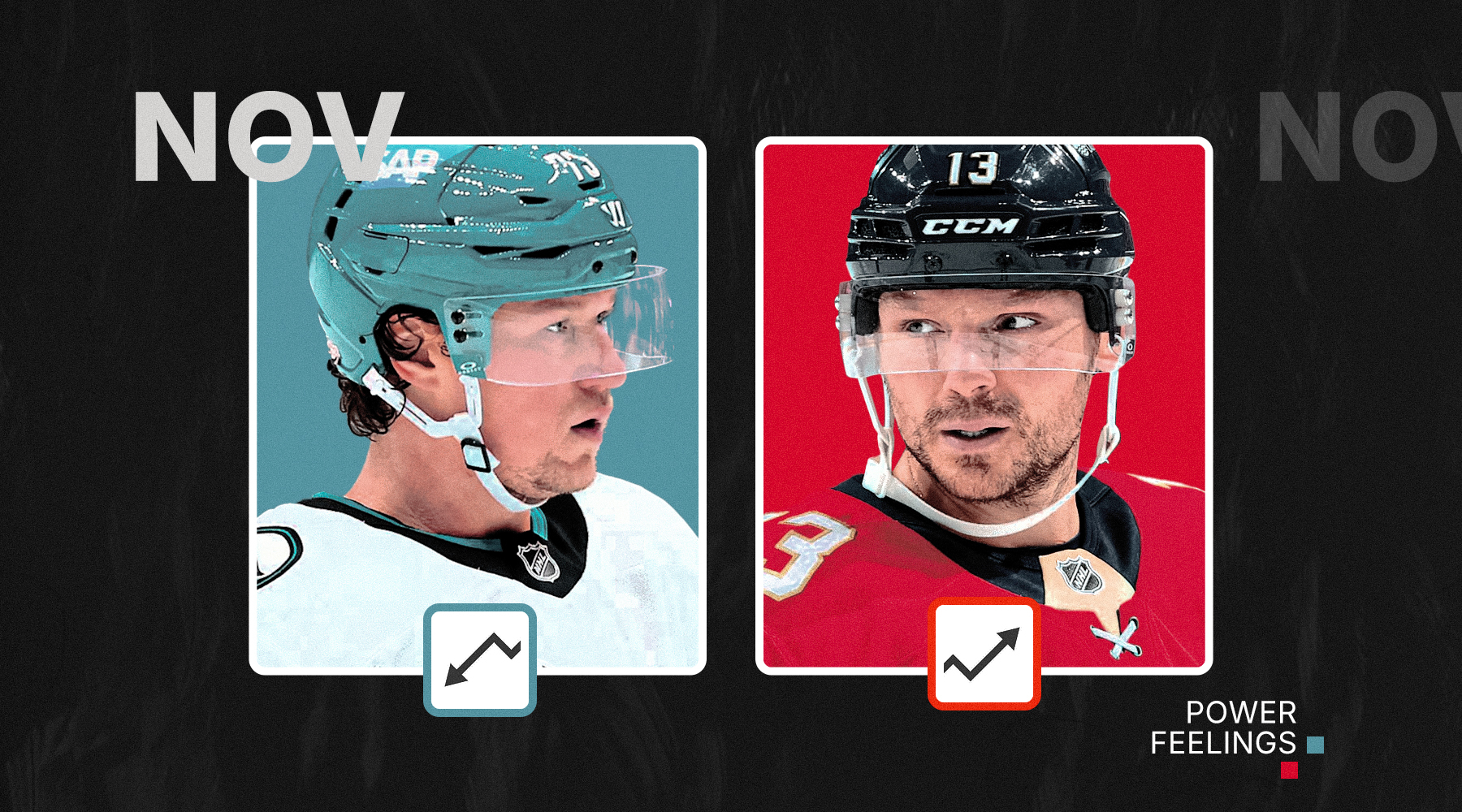Elite Prospects 3 Stars: Mr. November

For every team in the league, the season is only 10-12 percent completed, but of course that doesn't stop anyone from doing stuff like talking about the MVP race and speculating on what it would take for teams to drop out of the playoffs.
One of the things I like to think about at basically any time of the year, but certainly when one month rolls into the next, is how much teams will have to work to get to 100 points, which is what I generally consider to have been an unequivocally good season that ensures you a playoff spot. You or I may be convinced that, say, Colorado or Boston are going to turn it around or for others like Washington or Los Angeles to fade a bit, but it's important to look at what kind of hockey they're going to need to play for the remaining 70ish games to reach that mark.
Banked points are banked, right? Even if you go on a PDO-fueled winning or losing streak, you're either taking or losing out on those points.
With that in mind, I just wanted to highlight how little margin for error a few teams have built in, but also how potentially unsafe even the hottest-starting teams might be at this juncture.
Take, for example, the Pittsburgh Penguins. The whole goal of that organization the last few years has been to just get the Big Three back into the playoffs and see what happens. Well, at this point, they would need to play at a 106.6-point pace for the entire rest of the season to reach 100 points in what looks like a pretty competitive division. And while that may not sound entirely impossible, please note that the Penguins haven't had a season of 106 points or more since the last time they won a Stanley Cup. (Yeah, they posted a 112-point pace in the 56-game COVID season, but we're talking about doing that the full 82 and you get what I'm saying.)
The Boston Bruins? They'd need to play at a 105.1-point pace over the remaining 71 games to get to 100. They've shown the last few years that this is extremely doable, with their low since that aforementioned COVID season is… yeesh, 107 points. But every game they give away — and I'll talk more about this in a second — means the doomsday clock clicks one step closer to midnight.
Conversely, wow, the Washington Capitals are currently in a four-way tie for second in the league in points percentage, with 14 from nine games. Can't ask for much better than that and they're actually playing great. But still, to get to 100, they will need to play at a 96.6-point pace for the remaining 73 games of their schedule. Shouldn't be that difficult, except to say they haven't gotten to 96 points since 2021-22. I think it's safe to say that this season feels markedly different than last season or the one before that, but I guess that's my point: Things might feel dire or fantastic, depending on which team you're talking about, but it's been less than a month, so let's all take a deep breath.
Let's go:
3. The 60 Minutes sound
The way things are going in Boston right now, every muffled tick on Jim Montgomery, Don Sweeney, and Cam Neely's wristwatches has to feel like one of those really big thunderclaps that makes everyone in your home look at each other like, "Whoa."
Their scoring problems are well documented at this point and in this current 1-4-1 stretch, they've scored just nine goals while allowing 24. And it's not just bad luck, either. Yeah, they probably should have more than nine goals in that stretch (they're converting at just 5.8 percent) but they're minus-29 in shots and have only outshot opponents twice. They have just 80 scoring chances in all situations. It's flat-out not good enough, and as I've said before, it doesn't seem like there are many answers forthcoming.
As such, it feels like it's getting to be about pink-slip o'clock. And it's tough because I don't think coaches fluke their way to back-to-back seasons with like 110 points or whatever, but Montgomery isn't pressing the right buttons anymore, and I don't know how protected Sweeney can feel even if the usual fire-the-coach tactic usually works to at least temporarily insulate GMs from the same kind of consideration. There's only so much roster juggling any coach can do if his fourth line has been by far his best and most productive through 11 games.
But change is coming. They have a home-road back-to-back this weekend against the Flyers and Kraken, and even if they sweep it, you get the feeling it would take consecutive huge blowout "statement win"-style results to even slow the train that's chugging its way down the tracks. The reason the Bruins didn't really rebuild after Patrice Bergeron retired is that this is a team that wants to be in the playoff hunt every year. The two times they missed the postseason in the past decade they got to 93 and 96 points. They haven't been sub-.500 in nearly 20 years. The failures of their drafting and development can be linked in a lot of ways to the 15 years of constantly Going For It, not that it was a bad strategy for a team that's made it to three Stanley Cup Finals and cleared 100 points on 10 different occasions.
But a reckoning at the organizational level has to happen at some point, doesn't it? Sure feels that way. The Bruins are currently on pace for their worst season since 1997, and the second-worst since the expansion era.
Even if you think they can turn it around and at least compete for a playoff spot, finishing sub-.500 feels like it would be one of those "everyone's gotta go" conditions.
2. Top power plays
I love this time of year because it can make really funny stats leap off the page. Take, for example, the fact that four different teams have power plays running north of 30 percent right now, and another is at 29 percent.
If you're trying to figure out why the Winnipeg Jets are winning so much beyond "elite goaltending," it's the fact that they're averaging 1.3 power-play goals per game and scoring on almost 45 percent of their opportunities. In fact, the New York Islanders have only eight more goals in all situations than the Jets do just on the power play, and they've played the same number of games. What a world. Normally, you'd be worried about a team drawing just 29 power plays in 10 games — only four teams have drawn fewer — but if it's scoring 45 percent of the time, there's at least something to feel good about.
(Funny story: No one has drawn more power plays than the Bruins; they're running under 15 percent.)
Right now, the average PK is right around where it's been for years, just under 80 percent. So for the Jets and the Ottawa Senators to be the teams leading the way is just plain old fun. Less surprising that the Colorado Avalanche and Vegas Golden Knights are both north of 33 percent. I can't get a read on whether it's interesting that the New Jersey Devils are fifth, but I guess it probably is.
Conversely, only three teams are under 10 percent, "led" by the Buffalo Sabres at under 7 percent. I think that's maybe at least a little predictable, but the Toronto Maple Leafs and the Capitals being the other two teams is flat-out bizarre given who's shooting the puck for them.
Sometimes these are just fun little things to think about.
1. Taking up the yoke
Absolutely brutal news for the Edmonton Oilers. Amid a brutal stretch to start the season in which nothing seems to be going right, Connor McDavid gets hurt and will miss two or three weeks. They currently have a net special teams number of just 75.8 (13.3 percent on the power play and 62.5 percent on the PK) and losing a guy of that caliber, around whom so much of your success revolves, has to feel not like a run of the mill gut punch, but like a devastating liver shot.
So it's a good thing they have Leon Draisaitl, too. In the past week, during which the Oilers played four times, he is tied second in the league in points with seven — behind only Kyle Connor, but I've talked enough about the Jets today — and scored a league-leading five goals. He's up to 8-5—13 in 11 games, but frankly he's gonna have to post another couple weeks like this one where he either shoots the lights out or significantly increases his shot production if the Oilers are going to weather the storm in a way that keeps them in the playoff hunt.
Two weeks out from Oct. 29, when they announced the extent of McDavid's injury, is Nov. 12. They have five games in that stretch, three of them at home, and going even 3-2-0 would be nice if they don't give too many points away on overtimes in the three games against division opponents. But if you lengthen the absence to a full three weeks, that adds three or four games to the schedule depending on exactly when McDavid returns. One imagines that even if he's not healthy when the trip starts, he will travel with the team on their three-game road swing to Eastern Canada, but which of those three games he gets into is up in the air.
And so it potentially falls to Draisaitl to basically replicate what he did this week, scoring more than a goal a game, to keep the Oilers afloat. An unenviable task, but if there were one player in the entire league you'd want to have as your No. 2 who moves up the lineup, the list of guys in front of Draisaitl is either non-existent or extremely short. He has to make the best out of a bad situation, but he's got that power.


